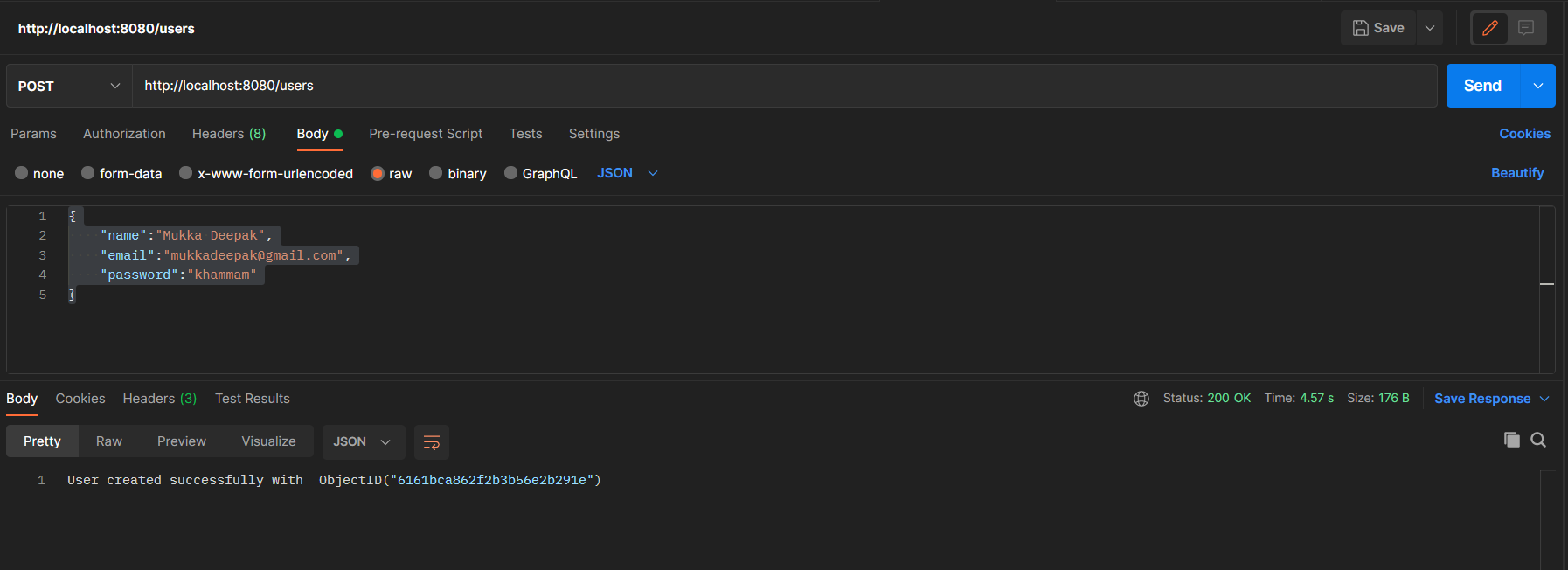Valet
Stateless Go server responsible for running tasks asynchronously and concurrently.
Overview
At its core, valet is a simple job queuing system and an asynchronous task runner. A task is a user-defined func that is run as a callback by the service.
Job
The implementation uses the notion of job, which describes the work that needs to be done and carries information about the task that will run for the specific job. User-defined tasks are assigned to jobs. Every job can be assigned with a different task, a JSON payload with the data required for the task to be executed, and an optional timeout interval. Jobs can be scheduled to run at a specified time or instantly.
After the tasks have been executed, their results along with the errors (if any) are stored into a storage system.
Pipeline
A pipeline is a sequence of jobs that need to be executed in a specified order, one by one. Every job in the pipeline can be assigned with a different task and parameters, and each task callback can optionally use the results of the previous task in the job sequence. A pipeline can also be scheduled to run sometime in the future, or immediately.
Architecture
Your callback functions can live in any repo and should be registered to your own build of valet. To unlock this level of flexibility, the service is provided as a Go pkg rather than a cmd, enabling the task registration before building the executable.
Internally, the service consists of the following components.
- Server - Exposes a RESTful API to enable communication with external services.
- Job queue - A FIFO queue that supports the job queuing mechanism of the service.
- Scheduler - Responsible for dispatching the jobs from the job queue to the worker pool and of course for scheduling the tasks for future execution.
- Worker pool - A number of available go-routines, responsible for the concurrent execution of the jobs.
- Storage - The storage system where jobs and their results persist.
The design intends to follow the hexagonal architecture pattern and to support modularity and extendability.
So far, valet provides the following interfaces and can be configured accordingly to function with any of the listed technologies.
API
- HTTP - Powered by gin. Find the swagger files under
doc/swagger/. - gRPC
Storage
- In-memory key-value storage.
- MySQL
- PostgreSQL
- Redis
Job queue
- In-memory job queue.
- RabbitMQ
- Redis
Installation
- Download the
pkg.
go get github.com/svaloumas/valet
- Define your own task functions in your repo by implementing the type
func(...interface{}) (interface{}, error).
package somepkg
import (
"github.com/svaloumas/valet"
)
// DummyParams is an example of a task params structure.
type DummyParams struct {
URL string `json:"url,omitempty"`
}
// DummyTask is a dummy task callback.
func DummyTask(args ...interface{}) (interface{}, error) {
dummyParams := &DummyParams{}
var previousResultsMetadata string
valet.DecodeTaskParams(args, dummyParams)
valet.DecodePreviousJobResults(args, &resultsMetadata) // Applies to pipelines.
metadata, err := downloadContent(params.URL)
if err != nil {
return nil, err
}
return metadata, nil
}
func downloadContent(URL string) (string, error) {
return "some metadata", nil
}
args[0]holds the task parameters as they were given through the API call for the job/pipeline creation.args[1]holds the results of the previous task only in case of a pipeline execution. Prefer to safely access the arguments by usingvalet.DecodeTaskParamsandvalet.DecodePreviousJobResultsto decode them into your custom task param structs.
-
Copy
config.yamlfrom the repo and set a configuration according to your needs. -
Initialize
valetin amainfunction under your repo, register your tasks to the service and run it.
mkdir -p cmd/valetd/
touch cmd/valetd/main.go
// cmd/valetd/main.go
package main
import (
"github.com/svaloumas/valet"
"path/to/somepkg"
)
func main() {
v := valet.New("/path/to/config.yaml")
v.RegisterTask("mytask", somepkg.DummyTask)
v.Run()
}
- Build and run the service.
-
To run the service and its dependencies as Docker containers, use the
Dockerfile,docker-composeandMakefilefiles provided.docker-compose up -d --build
-
Build and run the service as a standalone binary.
Optionally set the corresponding environment variables depending on your configuration options.
export POSTGRES_DSN= export RABBITMQ_URI= export MYSQL_DSN= export REDIS_URL=
go build -o valetd cmd/valted/*.go ./valetd
Configuration
All configuration is set through config.yaml, which lives under the project's root directory.
# Server config section
server:
protocol: http # string - options: http, grpc
http:
port: 8080 # int
grpc:
port: 50051 # int
# Job queue config section
job_queue:
option: rabbitmq # string - options: memory, rabbitmq, redis
memory_job_queue:
capacity: 100 # int
rabbitmq:
queue_params:
queue_name: job # string
durable: false # boolean
deleted_when_unused: false # boolean
exclusive: false # boolean
no_wait: false # boolean
consume_params:
name: rabbitmq-consumer # string
auto_ack: true # boolean
exclusive: false # boolean
no_local: false # boolean
no_wait: false # boolean
publish_params:
exchange: # string
routing_key: job # string
mandatory: false # boolean
immediate: false # boolean
redis:
key_prefix: valet # string
min_idle_conns: 10 # int
pool_size: 10 # int
# Workerpool config section
worker_pool:
workers: 4 # int
queue_capacity: 4 # int
# Scheduler config section
scheduler:
job_queue_polling_interval: 5 # int
storage_polling_interval: 60 # int
# Storage config section
storage:
option: memory # string - options: memory, mysql, postgres, redis
mysql:
connection_max_lifetime: # int
max_idle_connections: # int
max_open_connections: # int
postgres:
connection_max_lifetime: # int
max_idle_connections: # int
max_open_connections: # int
redis:
key_prefix: valet # string
min_idle_conns: 10 # int
pool_size: 10 # int
# Global config section
timeout_unit: second # string - options: millisecond, second
logging_format: text # string - options: text, json
Secrets
Currently, the secrets depending on the configuration are the following: MySQL DSN, PostgreSQL DSN, Redis URL and the RabbitMQ URI. Each can be provided as an environment variable. Alternatively, if you choose to use the provided Docker compose files, you can create the corresponding Docker secrets.
| Env variable | Docker secret |
|---|---|
MYSQL_DSN |
valet-mysql-dsn |
POSTGRES_DSN |
valet-postgres-dsn |
REDIS_URL |
valet-redis-url |
RABBITMQ_URI |
valet-rabbitmq-uri |
Usage
Create a new job by making a POST HTTP call to /jobs or via gRPC to job.Job.Create service method. You can inject arbitrary parameters for your task to run by including them in the request body.
{
"name": "a job",
"description": "what this job is all about, but briefly",
"task_name": "dummytask",
"task_params": {
"url": "www.some-fake-url.com"
},
"timeout": 10
}
To schedule a new job to run at a specific time, add run_at field to the request body.
{
"name": "a scheduled job",
"description": "what this scheduled job is all about, but briefly",
"task_name": "dummytask",
"run_at": "2022-06-06T15:04:05.999",
"task_params": {
"url": "www.some-fake-url.com"
},
"timeout": 10
}
Create a new pipeline by making a POST HTTP call to /pipelines or via gRPC to pipeline.Pipeline.Create service method. You can inject arbitrary parameters for your tasks to run by including them in the request body. Optionally, you can tune your tasks to use any results of the previous task in the pipeline, creating a bash-like command pipeline. Pipelines can also be scheduled for execution at a specific time, by adding run_at field to the request payload just like it's done with the jobs.
{
"name": "a scheduled pipeline",
"description": "what this pipeline is all about",
"run_at": "2022-06-06T15:04:05.999",
"jobs": [
{
"name": "the first job",
"description": "some job description",
"task_name": "dummytask",
"task_params": {
"url": "www.some-fake-url.com"
}
},
{
"name": "a second job",
"description": "some job description",
"task_name": "anothertask",
"task_params": {
"url": "www.some-fake-url.com"
},
"use_previous_results": true,
"timeout": 10
},
{
"name": "the last job",
"description": "some job description",
"task_name": "dummytask",
"task_params": {
"url": "www.some-fake-url.com"
},
"use_previous_results": true
}
]
}
Tests
Run the complete test suite.
docker-compose up -d
make test





